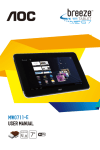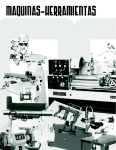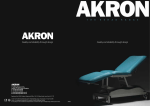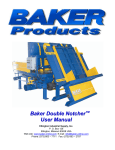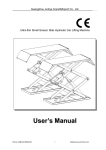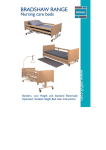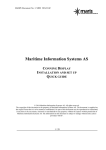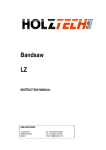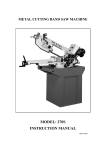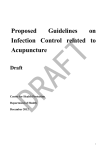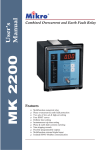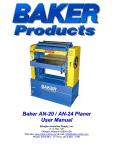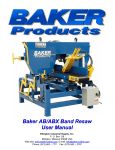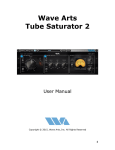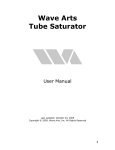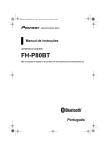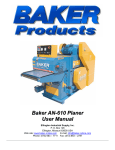Download Baker AN-912 Planer User Manual
Transcript
Baker AN-912 Planer User Manual Ellington Industrial Supply, Inc. P. O. Box 128 Ellington, Missouri 63638 USA Web site: www.baker-online.com E-mail: [email protected] Phone: (573) 663 – 7711 Fax: (573) 663 – 2787 Baker AN-20 / AN-24 Planer - Rev 1, 06/07; WWW.BAKER-ONLINE.COM 1 Table Of Contents Warranty…………………………………………………………………………………3 Defective Parts…………..…………………………………………………………3 Service Policy……………………..……………………………………………3 Rules for Safe Operation……..………………………………………………………………4 General Safety Rules for Woodworking Machinery… ……………………………….5-6 Additional Safety Rules for the Surface Planing Machine………………………………7 Specifications……………………………………………………………………8 Unpacking……………………………………………………………………8 Machine Legend……………..…………………………………………9 Installation………..………………………………………………………..10-11 Power Wire Connections………..…………………………………………12 Dust Noise Collection…………………………………………………………13 Emission……………………………………………………………13 Inspection Before Operation…………………………………………………………14 Machine Adjustments………………………………………………………15 Straight Knife Adjustment/Installation………………………………………………15 Spiral Cutter head Insert Installation………………………………………………16 Outfeed Table……………..………………………………………………………17 Infeed Table……………………………………………………………………18 Fence Adjustments………. …………………………………………………18 Operations……………..……….……………………………………………19-24 Maintenance & Trouble-shooting……………………………………………………….25-27 Electric Specification & Electric Connections………………………………28-29 Parts List……….……………………………………………………………19-20 Baker AN-912 Jointer - Rev 1, 06/07; WWW.BAKER-ONLINE.COM 2 Warranty Ellington Industrial Supply, Inc. machinery is warranted against defects in material or workmanship starting from the date of shipment from the manufacturing plant. This warranty is given solely to the “original purchaser” of the equipment and is in no way to be expressed or implied that it is transferable to any other parties without the written consent and approval from the CEO or Sales Manager of Baker Products. Our one (1) year warranty period covers all items built at our manufacturing facilities including structural frame, cowlings, doors, shafting, dust chutes and guards. We honor six (6) months of warranty coverage for miscellaneous vendor-purchased-supplied items including bearings, chain, sprockets, hydraulic components, etc. Ninety (90) days of warranty coverage is provided on all electrical parts. All electrical components and wiring has been installed in accordance with the National Electrical Code (NEC) of the United States of America. Ellington Industrial Supply, Inc. does not warranty this machine to meet any other requirements or jurisdiction of any electrical or safety codes of any other state, municipality, other country or jurisdiction The purchaser assumes all risk and liability whatsoever resulting from the use thereof whether used singularly or in conjunction with other machinery or apparatus, including, but not limited to, all matters resulting from sawdust generation. Note: No warranty is provided on any electrical components or parts if equipment is powered or connected to a roto-phase electrical converter in order to create a three phase power supply for operational current from a single phase source. Any change in materials, design, or performance intended to improve any product of Ellington Industrial Supply, Inc. shall not obligate Ellington Industrial Supply, Inc. to modify any previously manufactured equipment. This manual may contain details that if not properly followed can affect the performance of your equipment. You are responsible for proper use and maintenance of your equipment and we reserve the right to deny warranty work if deemed to be caused by a lack of proper maintenance or negligence by the owner or their employees. Defective Parts Parts claimed defective must be returned freight prepaid, to our plant in Ellington, Missouri. Any part determined defective due to faulty workmanship or materials will be replaced or repaired (at our option) free of charge, F.O.B. our plant. This warranty does not cover expendable items (i.e. drive belts, band wheels, conveyor belting, blades, cutters, guides, etc.). Except as expressly provided herein, this warranty is in lieu of all other warranties, expressed or implied, including a warranty of merchantability or fitness for a particular purpose. This warranty is “void” if any part of the unit has been tampered with, modified, altered, or operated with parts other than supplied or recommended by Ellington Industrial Supply, Inc. In no event shall Ellington Industrial Supply, Inc. be liable for special, indirect, incidental or consequential damages, however arising, including but not limited to, the loss of earnings or the cost of downtime. Service Policy In the event that you have any problems, call us at (573) 663-7711 any time between 8:00 AM and 5:00 PM (CST), Monday through Friday. A member of our trained staff will answer any questions you may have. The only charge is for replacement parts not covered by warranty or after our inspection we deem that the problem is due to operator error or lack of proper maintenance or neglect. If it is necessary for a member of our service department to visit your plant at your request, there will be a charge for this service. Call our service department for current prices. Retain this Information for your Records Model Number: …………………… Serial Number: …………………………………………………... Date of Purchase: ………………....Power Source:…………..Dust Removal: ….…………………... Baker AN-20 / AN-24 Planer - Rev 1, 06/07; WWW.BAKER-ONLINE.COM 3 Rules for Safe Operation The purpose of safety symbols and signage is to draw your attention to real or possible hazardous conditions that may exist when operating this equipment. Please remember that safety symbols and signage alone do not eliminate danger and are not substitute for proper training and education regarding operational hazards. This symbol and warning indicates a potentially hazardous situation, which, if not avoided, will result in death or serious injury. This symbol and warning indicates a potentially hazardous situation, which, if not avoided, could result in death or serious injury. This symbol and warning indicates a potentially hazardous situation, which, if not avoided, may result in minor or moderate injury. This warning provides notice and instruction regarding a potentially hazardous situation, which, if not avoided will result in serious injury or death. SAFETY EXPECTATIONS FOR OPERATING POWER EQUIPMENT ALWAYS… • ENSURE THAT TRAINED PERSONNEL OPERATE, MAINTAIN AND REPAIR THIS EQUIPMENT • TURN POWER OFF AND LOCKOUT / TAGOUT PRIOR TO PERFORMING MAINTENANCE • KEEP WORK AREA CLEAN AND WELL LIGHTED TO MINIMIZE OR ELIMINATE HAZARDS • KEEP CHILDREN AND VISITIORS AWAY FROM OPERATING EQUIPMENT • OPERATE THE EQUIPMENT AT THE RATE IT WAS DESIGNED FOR • KEEP GUARDS IN PLACE WHEN OPERATING EQUIPMENT • REMOVE TOOLS BEFORE RESUMING OPERATION • USE PROPER EXTENSION CORD • WEAR PROPER APPAREL AND AVOID LOOSE CLOTHING AND ACCESSORIES THAT COULD GET CAUGHT IN MOVING PARTS ALWAYS WEAR SAFETY GLASSES AND HEARING PROTECTION • AVOID “KICK-BACK” BY KNOWING WHAT CONDITIONS CAN CREATE IT • CHECK DAMAGED PARTS AND REPAIR OR REPLACE THEM IMMEDIATELY • NEVER… • LEAVE MACHINERY RUNNING OR UNATTENDED, ALWAYS TURN POWER OFF • OPERATE EQUIPMENT WHEN TIRED, FATIGUED OR UNDER THE INFLUENCE OF DRUGS OR ALCOHOL ALLOW UNTRAINED PERSONNEL TO OPERATE, MAINTAIN OR REPAIR THIS EQUIPMENT • No list of safety expectations can ever be complete as every work environment is as different as are the people operating the equipment. Always keep safety as your highest priority and always use this machine with caution and respect. Baker AN-912 Jointer - Rev 1, 06/07; WWW.BAKER-ONLINE.COM 4 General Safety Rules For Woodworking Machinery 1. Know your machine. For your own safety, read the operation manual carefully. Learn the machine applications and limitations, as well as specific potential hazards pertinent to this machine. 2. Keep guards in place and in working order. If a guard must be removed for maintenance or cleaning, make sure it is properly reattached before using the machine again. 3. Keep children away. All visitors should be kept a safe distance from the work area. 4. Make workshop childproof. Use padlocks or master switches, or remove starter keys. 5. Do not force the tool. It will do the job better and be safer working at the rate for which it was designed. 6. Use the right tool. Do not force the machine or attachment to do a job for which it was not designed. 7. Maintain tools with care. Keep tools sharp and clean for best and safest performance. Follow instructions for lubricating and changing accessories. 8. Disconnect tool before servicing or changing accessories such as blades and cutters. 9. Reduce the risk of unintentional starting. Make sure switch is in OFF position before connecting to power source. If power is interrupted during operation, turn off switches before restoring power. 10. Never stand on machine. Serious injury could occur if it tips over or if the blade is unintentionally contacted. 11. Wear proper eye protection. Also use a face or dust mask if operation is exceptionally dusty. 12. Wear proper apparel. Avoid loose clothing, gloves, neckties, rings, bracelets or jewelry, which could get caught in moving parts. Wear protective hair covering to contain long hair. 13. Always use push sticks to feed work piece whenever possible. 14. Do not over reach. Keep proper footing and balance at all times. Never reach around or over cutting blade. 15. Operate the machine in a dry, indoor place. Do not expose it to rain. Keep work area clean and well lit. 16. Check damaged parts. Before using the machine check to see that all parts are in working order, including the range and traverse of moving parts. Damaged parts should be repaired or replaced before using the machine. 17. Do not operate this machine while under the influence of alcohol or drugs. 18. Never leave the machine running unattended. Do not leave the machine until it has come to a complete stop. Baker AN-20 / AN-24 Planer - Rev 1, 06/07; WWW.BAKER-ONLINE.COM 5 19. This planer is designed and intended for use by properly trained and experienced only. If you are not familiar with the proper and safe operation of a planer, do not use until proper training and knowledge have been obtained. 20. Do not use this planer for other than its intended use. If use for other purposes, Yuan An Co. disclaims any real or implied warranty and holds itself harmless from any injury that may result from that use. . 21. Use the right tool at the correct speed and feed rate. Do not force a tool or attachment to do a job for which it was not designed. The right tool will do the job better and safer. 22. Do not operate this machine while tired or under the influence of drugs, alcohol or any medication. 23. Provide for adequate space surrounding work area and non-glare, overhead lighting. 24. Replace the warming labels if they become obscured or removed. 25. Turn off the machine before cleaning, Use a brush or compressed air to remove chips or debris—do not use your hands. Familiarize yourself with the following safety notices used in this manual ---Save These Instructions----- Baker AN-912 Jointer - Rev 1, 06/07; WWW.BAKER-ONLINE.COM 6 Additional Safety Rules For The Surface Planing Machine 1. Make sure cutter head rotates in a clockwise direction when viewed from the front of the jointer. If the cutter head rotates counterclockwise, then check the wiring of the machine. 2. Jointing safety begins with your lumber. Inspect your stock carefully before you feed it over the cutter head. If you have any doubts about the stability or structural integrity of your stock, do not made it. 3. Make sure maintain proper relationships of infeed and out feed table and cutter head path 4. Use a push block and never place your hand directly over the cutter head. 5. When jointing, do not stand directly at the end infeed and out feed of table. 6. Do not make jointer cuts deeper than 1/8” (3.2mm) 7. All operations must be performed with the guards in place. 8. Kickback: use extra care in the location of the jointer in the shop. Position the jointer so that a kicked back stock will strike will strike a wall and not endanger other person in the area. 9. Avoid tip-in: never apply pressure to stock directly over the cutter head. This may result in the stock tipping into the cutter head along with the operator’s fingers. Follow the 75 mm rule. Position hands away from extreme ends of stock. And push through with a smooth, even motion. 10. Avoid kickback: “Pull-out” and the danger of kicked back stock can occur when the work piece has knots, holes, or foreign materials such as nails. It can also occur when the stock is fed against the grain on the jointer. The grain must run in the same direction you are cutting. Before attempting to joint, or plane, each work piece must be carefully examined for tock condition and grain orientation. NOTE: at certain times it may be necessary to plane against the grain when working with a swirl grain wood or burls. With this type work the operator must use a lesser depth of cut and a slow rate of feed. 11. Hand safety: Ti is good practice to move the hand in an alternate motion from back to front as the hands directly over the cutter knife. As one hand approaches the knife remove it from the stock in an arc motion and place it place it back on the stock in a position beyond the cutter knife 12. Guards: be sure machine guards are in place and in good working order. Use them at all times on operation where they can be used. If a guard must be removed for any operation, make sure it is replaced immediately following completion of that operation. 13. Never: Surface stock less than 300mm long, or 75mm wide, or 75mm thick without a hold down push block. 14. 75mm Rule: when working a piece of wood on the machine, follow the 75mm radius rule. The hands must never be closer than 75mm to the cutter head. Baker AN-20 / AN-24 Planer - Rev 1, 06/07; WWW.BAKER-ONLINE.COM 7 Specifications Model Table area Cutter head diameter Cutting circle Max. cutter head speed Straight Knife size Wedge Size (Straight Knife) T.C.T. insert size for spiral cutter head Max depth of cut single board Motor Dust port Belts Net weight Machine dimension Noise (Straight Knifes) AN-912 12” x 79.5” (305 x 2020mm) 4” (97mm) 4” (100mm) 5200 RPM 12” x 1-1/8” x 1/16” (305x30x3mm) 12” x ¾” x 3/8” (305x19x10mm) ½” x ½” x .078” (14x14x2.0mm) 1/8” (3.2mm) 3 HP 4” (100mm) two V-belt 992 lbs (450kgs) 6’-6” x 2’ x 3’-2” (201x58x95cm) 70dB Un-Packing Carefully unpack the machine from the crate and ensure that all parts are present and free from damage. If any parts are missing or damaged, contact your local dealer. Clean the anti-corrosive oil from all surfaces of the machine using a cloth soaked in kerosene. Do not use lacquer thinner or any volatile solvents, and these can damage the surface of the machine. Do not move any component of the machine until the anti corrosive oil has been removed. The cutter head knives are extremely sharp! Use caution when cleaning the cutter head and surrounding area! Failure to do so may cause serious injury! Baker AN-912 Jointer - Rev 1, 06/07; WWW.BAKER-ONLINE.COM 8 Machine Legend 1.Cutterhead: the cutter head is the cylindrical assembly that holds each of the three joiner knives or carbide cutter. It spins on a horizontal axis between the infeed and out feed table, and is covered by the cutter head guard when the jointer is not in use. 2.Infeed table: The infeed table is the table where the cutting operation begins. When standing in front of the jointer, it is on the right hand side. The broad wood travels right to left. From the infeed table across the cutter head, and onto the out feed table. 3.Outfeed table: the out feed table is the table where the cutting operation ends. 4.Fence: the jointer fence is the adjustable cast iron surface that the wood lock runs along when jointing and surface planing. The fence is adjustable from 45° to 90° with the infeed and out feed table. 5.Table lock handles: the handles that must be loosened before the height of the tables can be adjusted. They are then tightened after the height is properly set. 6. Adjustment shaft: controls the height of the infeed and out feed table. 7.Cutterhead Guard: the metal guard hat covers the cutter head when Wood stock is not passing over the jointer. 8. Lock handle for Vertical adjustment: 9. Main switch 10.Operate panel 11.Manual Scale: 6. 5. 3. 8. 7. 1. 5. 4. 11. 2. 6. 10. 9. Baker AN-20 / AN-24 Planer - Rev 1, 06/07; WWW.BAKER-ONLINE.COM 9 Installation Mount the machine on a solid foundation, preferably a concrete floor, and bolt the machine to the floor through the holes provided in the base. The machine area should be clean, dry, well ventilated, and well lighted. Since the jointer can create a high volume of noise, the site selection should be one which minimizes reverberant sound from walls, ceilings and other equipment. 1. Remove the crate from around the planer and any fasteners securing the planer to the skid. 1.1 Using a fork life (1) Fork life truck must be a minimum of 2.5 tons capacity. (2) Make sure that forks do not touch any delicate part of the machine. (3) Make sure machine is in balance. (4) Machine weight 330kgs Figure 1 2 Place straps under the body of this planer and lift the machine off the skid. (1) The safe load of straps is 1000kgs at least. (2) The planer should be located on a sturdy floor, preferably concrete, in a dry area with sufficient lighting. Baker AN-912 Jointer - Rev 1, 06/07; WWW.BAKER-ONLINE.COM 10 (3) Leave enough space around the machine for loading and offloading stock and routine maintenance work. (4) Exposed metal areas of the planer have been factory coated with a protestant. This should be removed with a soft cloth and kerosene. Do not use an abrasive pad. Do not let solvent contact the plastic parts of the machine, as it may damage them. (5) Requirement of the space OPERATOR Height space Hmin=2000mm Figure 2 Electrical connections must be made by a qualified electrician in compliance with all relevant codes. The machine must be properly grounded to help prevent electrical shock and possible fatal injury. Baker AN-20 / AN-24 Planer - Rev 1, 06/07; WWW.BAKER-ONLINE.COM 11 Power Wire Connections L1 L2 L3 N Green Wire Electrical connections must be made by a qualified electrician in compliance with all relevant codes. The machine must be properly grounded to help prevent electrical shock and possible fatal injury. Main Motor Start ON OFF Main Motor Stop Brake Release Emergency Stop Main Switch Warning Light Figure 3 1. The Jointer may be fitted with a correct volt, be ”hard-wired” directly to your electrical panel. If hard-wired to a panel, make sure disconnect is available for the operator. 2. Power supply : 3~ 50Hz 400V An-912:6A A-916:10A An-920:15A Degree of Protection :IP54 3. Make sure the machine’s wire is disconnected from the power source. If it is hard-wired. Make sure the fuses have been removed or the breakers have been tripped in the circuit to which the saw will be connected. Place a warning placard on the fuse holder or circuit breaker to prevent it being turned on while the machine is being wired. Always follow proper Lock Out/Tag Out procedures when performing any wiring on this machine. 4. Make sure the voltage of the power source corresponds to the power source corresponds to the voltage of the planer as recorded on the motor plate 5. Open the electrical connect box on the rear side of the machine (figure3) by loosening the screws. 6. Connect the three phases to terminals marked L1, L2, L3 7. Connect the green neutral wire to terminal ”PE” 8. Connect the machine to power (or install the fuses or reset the breakers at the power source). 9. Test the rotation of the cutter head. Turn on the main power switch and then the main motor switch (figure 3). The pulley on the main motor should rotate counterclockwise. 10. If it rotates clockwise, stop the machine with the red stop button (Figure 3). Disconnect machine from power source, and exchange leaks L1 and L3 11. Reconnect power, and close the electrical cover. Baker AN-912 Jointer - Rev 1, 06/07; WWW.BAKER-ONLINE.COM 12 After prolonged use of the planer, the cast iron frame and areas around the cutter head may be hot. Dust Collection It is strongly recommended this planer be connected to a dust extraction system, via the 4”(100mm) dust port at the rear of the planer. Your dust collector should have at least 1500 CFM capacity. And the required airflow speed at the end of flexible hose is 30-34m/sec. The dust extraction system shall be earthed. Noise emission The figures quoted are emission levels and are not necessarily safe working levels. Whilst there is a correlation between the emission levels and exposure levels, this cannot be used reliably to determine whether or not further precautions are required. Factors that influence the actual level of exposure of the work force include the characteristics of the workroom. The other sources of noise, etc. i.e. the number of machines and other adjacent processes. Also the permissible exposure level can vary from county to country. This information, however will enable the user of the machine to make a better evaluation of the hazard and risk. Baker AN-20 / AN-24 Planer - Rev 1, 06/07; WWW.BAKER-ONLINE.COM 13 Inspection Before Operation Before turning the machine power on, check that all screws are tight, that all mechanical functions work freely, and that the cutter head turns freely without knife contact with the rear noise-dampener or front noise-dampener. Periodic or regular inspections are required to ensure that the machine is properly adjusted, that all screws are tight, all belts are in good condition, that dust has not accumulated in the electrical enclosures, and that there are no loose or worn electrical connections. Check the motor and switch-wiring diagram for proper voltage connection before applying power to the machine. Turn the main drive motor on momentarily to check for proper direction of rotation. Correct as required. Cutter head should rotate clockwise when viewed from the stand in front of the jointer. Run the machine without cutting for a short period of time to check that all power functions are operating properly. Be sure to read and understand the operating instruction manual using the jointer. Loose hair and clothing could get caught in machinery and cause serious personal injury. Keep loose clothing rolled up and away from machinery. Damage to your eyes, lungs and ears could result from failure to wears safety glasses, a respirator, and hearing protection while using this machine Baker AN-912 Jointer - Rev 1, 06/07; WWW.BAKER-ONLINE.COM 14 Machine Adjustments Straight Knife Adjustment/Installation 1. Turn the machine off and disconnect it from the power source. 2. Clean all dust, chips, pitch and accumulated foreign matter from the cutter head slot and from its gib. Remove the cutter head guard to expose the top of cutter head. 3. Loosen the gib screws that press the knife to the gib. 4. Place the knife gauge on the out feed table, check the knife height when rotate the cutter head by the hand. The jip should solidly with the feet resting on the out feed table and the knife edge as shown in Figure 4. If the knife is adjusted properly, the knife setting gauge should rest flush across to out feed table and onto the top edge of the knife. if the knife dose not make contact, or if the knife causes the adjusters legs to not seat flush on out feed table the knife need to be adjusted. Figure 4. Setting out feed table adjust the knife of height with finish stock 5. Repeat the preceding method on successive knives making sure that the height from knife to table is the same within 0.05-0.07mm. Note: If all knives have been removed, a new set must be installed without locking the gibs until all knives and gibs are in and the gib screws lightly in place. The locking process should precede working from the center out on each knife and locking all gib screws once. Repeat the same sequence until all screws are equally tight. Locking one knife in without the others in position can cause cutterhead distortion. 6. After all knives have been adjusted, recheck all gib screw to be sure they are tight. Loose gib screws can result in knife being thrown out of the cutter head, causing severe damage to the machine and possible serious or fatal injury to the operator or bystanders. Baker AN-20 / AN-24 Planer - Rev 1, 06/07; WWW.BAKER-ONLINE.COM 15 Use extreme caution when working on or near the cutting knives! The knives are very sharp and extremely dangerous! Any adjustment or maintenance of knives should be performed on all three knives at the same time. Failure to do this may result in an unbalanced cutterhead, which will lead to bearing failure! Spiral Cutter head Insert Installation: 1. 2. 3. 4. Check cutter head insert size 14 x 14 x 2.0mm and angle 30° Clean cutter head & insert, set the insert in position, lubricate the M6 x 1.0 screw Use an air driver to adjust air pressure to 2kg/cm2 to pre–set the insert. After the pre-setting of insert, adjust air driver pressure to 6kg/cm2 to tighten screws. The torque is 0.55-0.58 kgf-m. Baker AN-912 Jointer - Rev 1, 06/07; WWW.BAKER-ONLINE.COM 16 Out feed Table: The table must be aligned to the highest point of the knife edge. If the out table is set too height, the stock will hit the front edge of the out feed table and will be impossible to feed over the jointer. If the out feed table is set too low, the trailing end of the stock ill fall into the cutter head and snip will occur. 1. Rotate the cutter head by turning the motor pulley. Do not grab the cutter head itself. Bring a knife-edge to approximate apex of its arc. 2. Loosen the out feed table lock handle, push the out feed table adjust shaft until the out feed table is nearly flush with the knife-edge. 3. Position a finish-stock the out feed table. Extend the finish-stock over the middle of the cutter head as shown in Figure3. . 4. Raise or low the out feed able with the out feed table adjust shaft until the finish-stock barely touches the top of knife-edge. 5. Tighten the out feed table lock handle. 6. Recheck the out feed table alignment with each of the cutter head knifes and re-adjust as necessary 7. Once properly set, the out feed table height only need to be change when the knife is resharpened. Baker AN-20 / AN-24 Planer - Rev 1, 06/07; WWW.BAKER-ONLINE.COM 17 Infeed Table: To adjust the infeed table 1. The infeed table can be adjusted the same way as the out feed table. Loosen the infeed table lock handle. 2. Place a finish-stock on the out feed table so it hangs over the infeed table. Turn the cutter head so that the knives are not touching the straightedge Figure 5. 3. Loosen the infeed table lock handle. Raise the infeed table until it just touching the straightedge as shown in figure. Tighten the table lock knob. 4. Adjust the depth of cut scale to read “0” Figure 6 Figure 5 setting the scale Figure 6 setting the depth of out scale. Fence Adjustments 1. Place a square on the out feed table fairly close to cutter head as shown in figure 5. 2. While holding the fence-adjusting handle, loosen the angle setting lock handle and adjust the fence angle as shown in figure 7. 3. Tighten the angle-setting handle, recheck the fence angle. Figure setting the 90° of fence. Baker AN-912 Jointer - Rev 1, 06/07; WWW.BAKER-ONLINE.COM 18 7 WARNING Two hand hold the Knob of fence while adjusting the fence Operations Test Run 4. Then assembly is finish and adjustments are done to your satisfaction, you are ready to test run the machine. 5. Turn on the power supply at the main switch. Press the START button. Make sure that your finger is poised on the Stop button, just in case there’s a problem. The jointer should run smoothly with little or no vibration or rubbing noises. Strange or Unnatural before operating the machine further. 6. If you cannot easily locate the source of an unusual noise or vibration, contact our service department for help. Stock Inspection If the stock has large or loose knots, consider finding another work-piece. Knots in a work-piece can be dangerous to the operator, as well as destructive to equipment. When jointing always cut with the grain rather than against it. Cutting against the grain chips the wood instead of cutting it, making the work-piece rough and irregular. Look at the side of your board. If the direction of the grain structure facing the cutter head runs toward the cutter head as it sits on the infeed table. Support work peice longer than the infeed or out feed table (e.g. by table extensions, supporting rollers, etc.) Examine the work peice, as to possible faults as: -foreign bodies; -knots; -shakes/cuppings; warped/bored wood. Surface Planing The purpose of planing on a jointer is to produce one flat surface. The theory behind this is that once you have one flat surface on a board, the board can then more readily be milled to precise, flat dimensions on a thickness planer. It is nearly impossible to surface plane both sides of a board effectively because the two surfaced sides will retain any warps, cup or twists. 1. Inspect your lumber for soundness and grain direction. 2. If the stock is cupped, place the concave side down and slowly feed it over the cutter head as shown in figure 8. Baker AN-20 / AN-24 Planer - Rev 1, 06/07; WWW.BAKER-ONLINE.COM 19 3. Inspect your results. Most likely, many passes will be necessary before your lumber has a flat surface. 4. If the stock has large or loose knots, consider finding another work piece. Knots in a workpiece can be dangerous to the operator, as well as destructive to equipment. Edge Jointing The purpose of edge jointing is to produce a finished, flat-edged surface that is suitable for jointery or finishing. Jointing is also a necessary step prior to ripping stock to width on a table saw or radial arm saw. 1. Make sure the fence is set to 90°. Double check it with a square. 2. Inspect stock for soundness and grain direction. 3. If the board is bowed, place the concave edge down on the infeed table. 4. Holding the stock firmly against the fence and table, feed the stock slowly and evenly over the cutter head . Beveling Beveling an edge is essentially the same operation as edge jointing, except that the fence is titled to a specified angle. Use extra care to ensure that the edge makes solid contact with the infeed and out feed tables at all time. 1. Use a bevel gauge to determine the desired angle. Then use the bevel to transfer this angle to the fence. 2. Tilt the fence by loosening the angle setting lock knob and moving the fence to the desired angle. Lock the handle. 3. Inspect stock for soundness and grain direction. 4. Slowly and evenly feed stock through the cutter head. Make sure the face of the stock is completely flat against the fence and the edge is making solid contact on the infeed and out feed table. 5. Achieving the full bevel will probably take several passes. Remember not to take more than 3mm in one pass. Taper Cuts One of the most useful jointer operations is cutting an edge to a taper. The method can be used on a wide variety of work. Tapered legs of furniture are a common example. Instead of laying the piece on the infeed table, lower the forward end of the work onto the out feed table. Do this very carefully, as the piece will span the knives, and they will a “bite” from the work with a tendency to kick back unless the piece is firmly held. Now push the work forward as in ordinary jointing. The effect is to plane off all the stock in front of the knives to increase depth, leaving a tapered surface. Baker AN-912 Jointer - Rev 1, 06/07; WWW.BAKER-ONLINE.COM 20 The ridge left by the knives when staring the taper may be removed by taking a very light cut according to the regular method for jointing, with the infeed table raised to its usual position. Practice is required in this operation, and he beginner is advised to make trial cuts on waste material. Taper cuts over part of the length and a number of other special operation can easily be done by the experienced craftsman. Baker AN-20 / AN-24 Planer - Rev 1, 06/07; WWW.BAKER-ONLINE.COM 21 Methods of work Fatting and edging work pieces up to 75mm thickness Preparing for flatting Set the cutter head guard to match the thickness of the work piece. Push the work piece with the right hand only a little under the guard as shown in Figure 8. Flatting With hand flat on the work piece, push forward on the infeed table and then glide or pass over the guard with one hand after the other. As soon possible, continue pushing the work piece forward with both hands on the out feed table. as show Figure 9. Figure 8. Preparing for flatting Figure 9. Flatting Preparing for edging Place the work piece against the fence and move it with the right hand forward to about the front edge of infeed table lip. With the left hand bring the guard up to the work peice. The guard should rest upon the out feed table as show Figure 10. Edging Press the work piece, with the left hand, e.g. first closed, thumb on the work piece, against the fence and the out feed table. Move the work piece forward regularly with the right hand, e.g. fist closed thumb on the work piece. Figure 10. Preparing for edging Figure 11. edging Baker AN-912 Jointer - Rev 1, 06/07; WWW.BAKER-ONLINE.COM 22 Flatting and edging work piece of more than 75mm thickness Flatting Lower the guard on to the table and adjust it horizontally to the work piece. Straighten the work piece, with flat hand hands beside the guard, along the fence Edging Move the work piece forward with both hands. In doing so, the left hand, e.g. fist closed, presses the work piece against the fence and the out feed table. The right hand lies upon the work piece. Lay the right hand the work piece when pushing on the out feed side. Figure 12/13. Edging work piece of more than 75mm thickness Flatting and edging work piece of small section(e.g. ledges) Flatting Push the work piece forward with flat hands as in case of work piece p to 75mm thickness Edging Put the work piece, with the hand(e.g. fist closed), against the fence and the table, and push it forward. The guard is adjusted horizontally up to the fence and rests and upon the work piece. Figure 14. Flatting and edging work piece of small section Flatting and edging short work piece Baker AN-20 / AN-24 Planer - Rev 1, 06/07; WWW.BAKER-ONLINE.COM 23 Flatting Press the work piece with the flat hand on the infeed table and move it forward with the work holder in the right hand. glide or pass with the left hand over the guard and , as soon as the work piece rest also upon the out feed Ensure that the work holder is not thicker that the work piece. Edging Press the work piece, with the left hand, fist closed, against the out feed fence and table, and move it forward with the work holder. Figure 15/16. Edging short work piece Beveling or chamfering Beveling or chamfering at the fence Place the work piece with the right hand against the inclined fence. Position work piece and guard as shown in the figure17/18. Figure 17/18. Edging short work piece Baker AN-912 Jointer - Rev 1, 06/07; WWW.BAKER-ONLINE.COM 24 Maintenance General Before and intervention on the machine, disconnect it from the electrical supply by pulling out the plug or switching off the main switch! Follow lockout/tagout procedures. Failure to comply may cause serious injury. Regual periodic maintenamnce on the jointer will ensue its optimum performance. Make a habit of inspecting the machine. All time you use it. Check the folloeing conditions and repair or replace if necessary. 1. worn switch 2. worn or damaged cords and plugs 3. loose mounting bolts. 4. damaged V-belt. 5. any other condition that could hamper the safe operation of this machine. 6. the guard should be inspected frequently and cleaned and concerning state of the guards any destruction whenever necessary. If they have any destruction, shall be order our agent for new guard. 7. The table should be kept clean and free of rust or deposits. Lubrication: Since most of the bearings are sealed and permanently lubricated, simply leave them alone until they need to be replaced. The cutter head bearings do need grease after every 100 hours of use. Unplug the machine and grease each of the two grease fittings located on each end of the cutter head. The front grease fitting is under the cutter head guard and other is the bottom edge of the fence. Tables Table could be kept rust-free. V-belt Inspect regular for wear; replace if necessary with a size A-49 belt. Baker AN-20 / AN-24 Planer - Rev 1, 06/07; WWW.BAKER-ONLINE.COM 25 Troubleshooting: Operating Problems Trouble Probable cause Remedy Snipe(NOTE: Snipe can be minimized but not eliminated) Dull knives. Reverse or replace knives. Planing wood with high moisture content Dull knives. Too heavy a cut Knives cutting against grain Dull knives Dull knives. Too heavy a cut Moisture content too high. Remove moisture content from wood by drying, or choose other stock Reverse or replace knives Adjust proper depth of cut. Cut along the grain. Reverse or replace knives. Reverse or replace knives. Adjust proper depth of cut. Remove moisture content from wood by drying, or choose other stock. Reverse or replace knives. Increase speed. Raise out feed table until it aligns with tip of knife. Raise out feed table until it aligns with tip of knife. Raise both table ends by adjusting four under the table. Lower table ends by adjusting the four hexagon-head under the tables. Fuzzy Grain Torn Grain Rounded, Raised surface Rounded, glossy surface Finished stock is concave on the end Back end of stock is thick than front end Finished stock is concave in the middle Ends of finished stock are cut more than the middle Dull knives. Feed speed too slow Knife is higher than out feed table Knife is higher than out feed table Both table have too much end fall Table end are raised higher than the middle Baker AN-912 Jointer - Rev 1, 06/07; WWW.BAKER-ONLINE.COM 26 Troubleshooting: Mechanical & Electrical Problems Trouble Probable Cause Machine will not Overload automatic start/restart or reset has not reset. repeatedly trips circuit breaker or blows fuses Remedy When planer overloads on the circuit breaker built into the motor starter, it takes time for the machine to cool down before restart. Allow unit to adequately cool before attempting restart. If problem persists. Check amp setting on the motor starter inside the electrical enclosure. One cause of overloading trips which are not electrical in nature is too heavy a cut. The solution is to take a lighter cut. If too deep a cut is not the problem, then check the amp setting on the overload relay. Match the full load amps on the motor as noted on the motor plate. If amp setting is electrical lead. Check amp setting on motor starter. Building circuit Verify that planer is on circuit of correct size. If circuit breaker trips or fuse size is correct, there is probably a loose electrical blows. lead. Check amp setting on motor starter Loose electrical Go through all the electrical connections on the connections. planer including motor connections, verifying the tightness of each. Look for any signs of electrical arcing which is a sure indicator of loose connections or circuit overload. Motor starter failure Examine motor starter for burned or failed components. If damage is found, replace motor starter. If motor starter looks okay but is still suspect, you have two options: Have a qualified electrician test the motor starter for function, or purchase a new starter and establish if that was the problem on change out. Baker AN-20 / AN-24 Planer - Rev 1, 06/07; WWW.BAKER-ONLINE.COM 27 Electric Specification & Electric Connections Mold AN-912 Power Range Setting Spindle Motor TR1 Electric cable cross-section Main electric cable cross-section FU1 Full load Current 2..25kw 5-8A 7A 2.0mm 2.0mm 6A 6A Power Supply 3~ 50Hz 400V 25 Baker AN-912 Jointer - Rev 1, 06/07; WWW.BAKER-ONLINE.COM 28 26 F1 F1 F1 F2 F3 F4 KA1 KT1 KM1 TC1 FR1 Electric Parts List Item QS1 Designation and Function Disconnection switch FU1 FU2 FU3 FU4 TC1 M1 SB1-SB3 SB4 KM1 KA1 Fuse Fuse Fuse Fuse Transformer Motor Push button switch Turn Switch Contactor Relay Technical Data Ith= 16A Ue=Ui=690V 10A/600V 2A/600V 2A/600V 2A/600V 0.3KVA 3.7KW/400Vac 3A 600V 3A 600V 3.7kW/380V 110V 10A 2a2b KT1 FR1 YB1 Timer Overload Relay Brake 0~10 sec. 9-13A 13W/220V Remarks EN60947-3 EN60269-1 EN60269-1 EN60269-1 EN60269-1 EN60742 EN60034-1 EN60947-1 EN60947-1 EN60947-3 IEC60255-1 IEC60255-23 IEC947-4-1 IEC947-4-1 Baker AN-20 / AN-24 Planer - Rev 1, 06/07; WWW.BAKER-ONLINE.COM 29 Parts List ITEM DESCRIPTION QTY 031 Star button 1 208 Gib screw 1 032 Stop button Cap. Screw 033 M8*30 1 209 cutter head pulley 1 4 210 Motor pulley 1 211 key. 1 101 Cutter head guard 1 212 Set screw 1 1 102 Hinge 1 213 Motor plate 1 005 Plat LH 1 103 Sprng pin 10*50 1 214 Hex head screw 4 006 Hex nut M16 4 104 Cup screw M8*25 2 215 Hex nut 12 007 Bed pivot rod 1 105 Guard bar 1 1 008 Adjust pivot shaft 2 106 Knob 1 009 knob 2 107 Knob 1 010 Handle M10*30 2 216 Housing RH Housing cover 217 RH 218 Bearing 6206 1 108 Fence 1 011 Bed pivot rod 2 219 Bear 6305 1 109 Shaft 1 012 Main pivot body 2 220 Hex head screw 4 1 013 Bed pivot rod 1 221 Motor 1 014 bed 1 4 222 Belt A-49 2 015 Noise dampener 1 2 230 Spiral cutter head 1 016 bed 1 1 231 T.C.T inserter Cup screw for 232 inserter 72 017 Noise dampener 110 Knob Cup screw 111 M12*250 112 Fence rod Fence adjustment 113 rod 114 Hex nut M12 018 Electrical box 1 019 Plate 1 020 plate Phillips head 021 screw M4*8 022 Knob screw. 1 023 Cover for motor 1 024 Hinge 2 025 Wash M6 1 026 1 001 Base Cap. Screw 002 M10*30 Cap. Screw 003 M10*55” 004 Body Phillips head screw M6*20 028 Plat R.H Phillips head 029 screw M6*20 030 Emergence Button 027 4 8 4 1 4 1 6 1 2 6 115 Lock handle M12 Thick washer 116 M12 Lock handle 117 M12*100 118 Fence body 1 119 Cup screw M8*40 4 120 Fence seat 1 201 Housing, LH. Housing cover 202 L.H.” 203 Nut 25ler 1 1 204 Cutter head 1 205 Knife gib 3 206 knife. Knife adjustment 207 screw 3 1 72 8 2 1 1 6 Baker AN-912 Jointer - Rev 1, 06/07; WWW.BAKER-ONLINE.COM 30 18/24 30






























